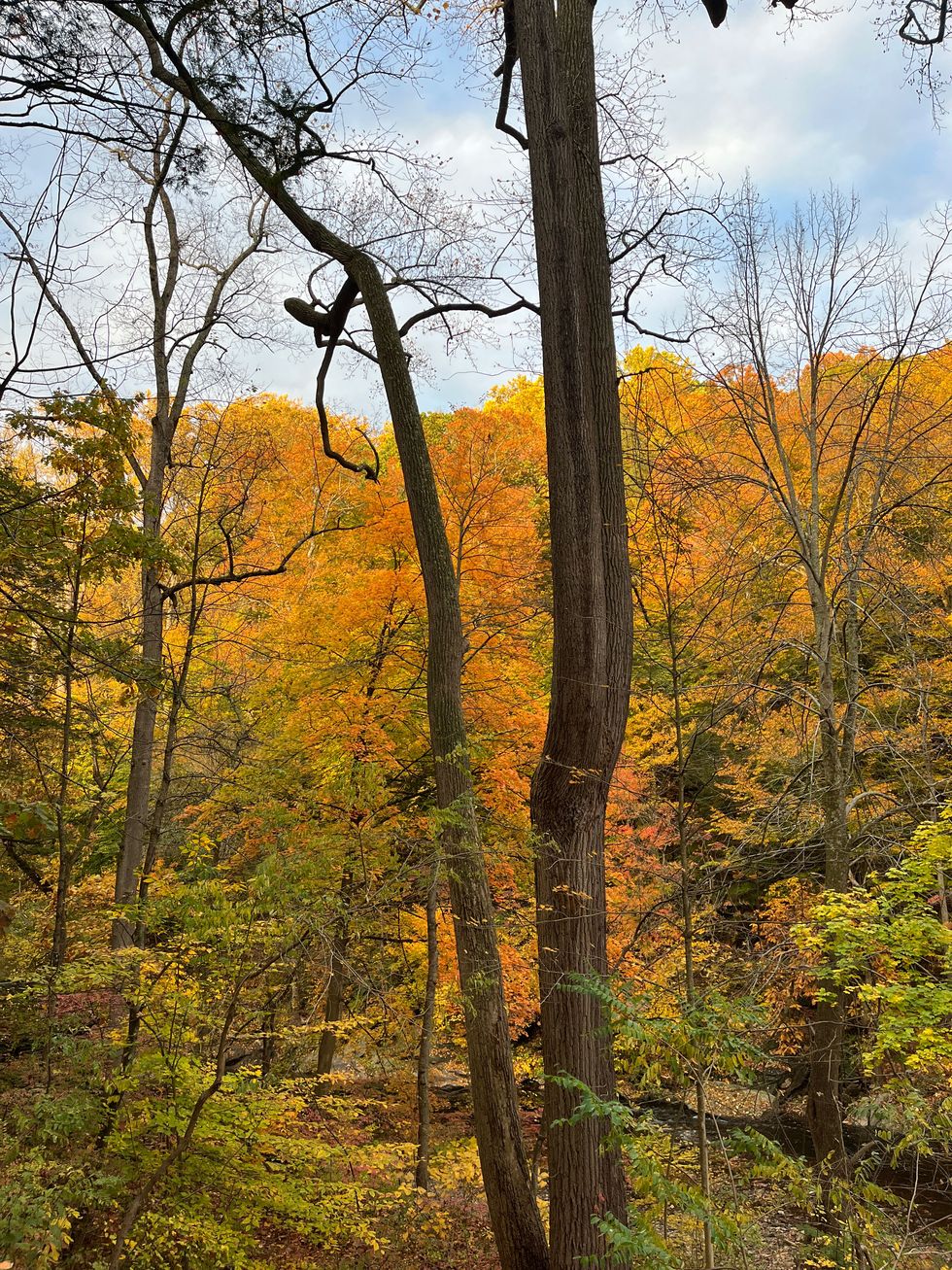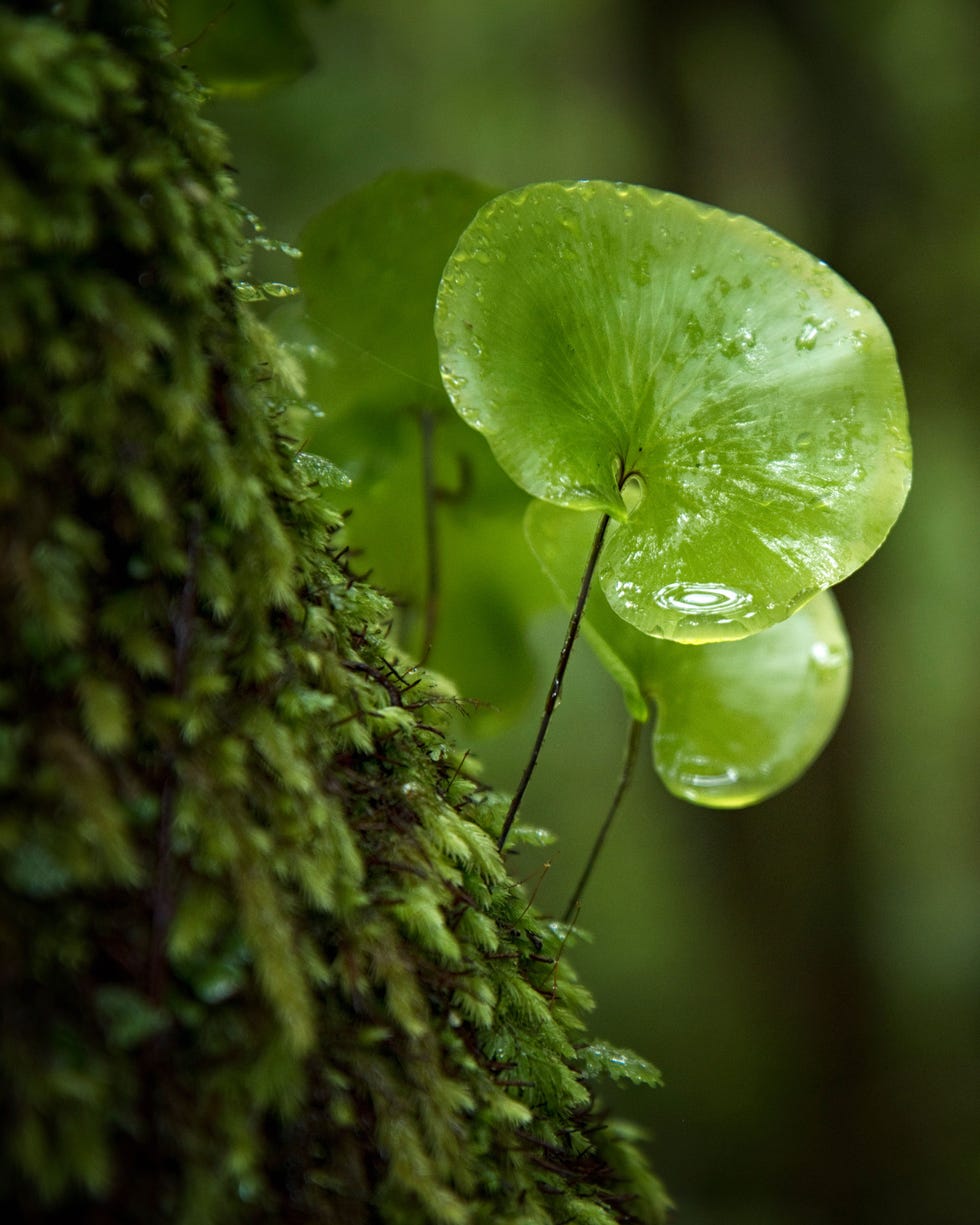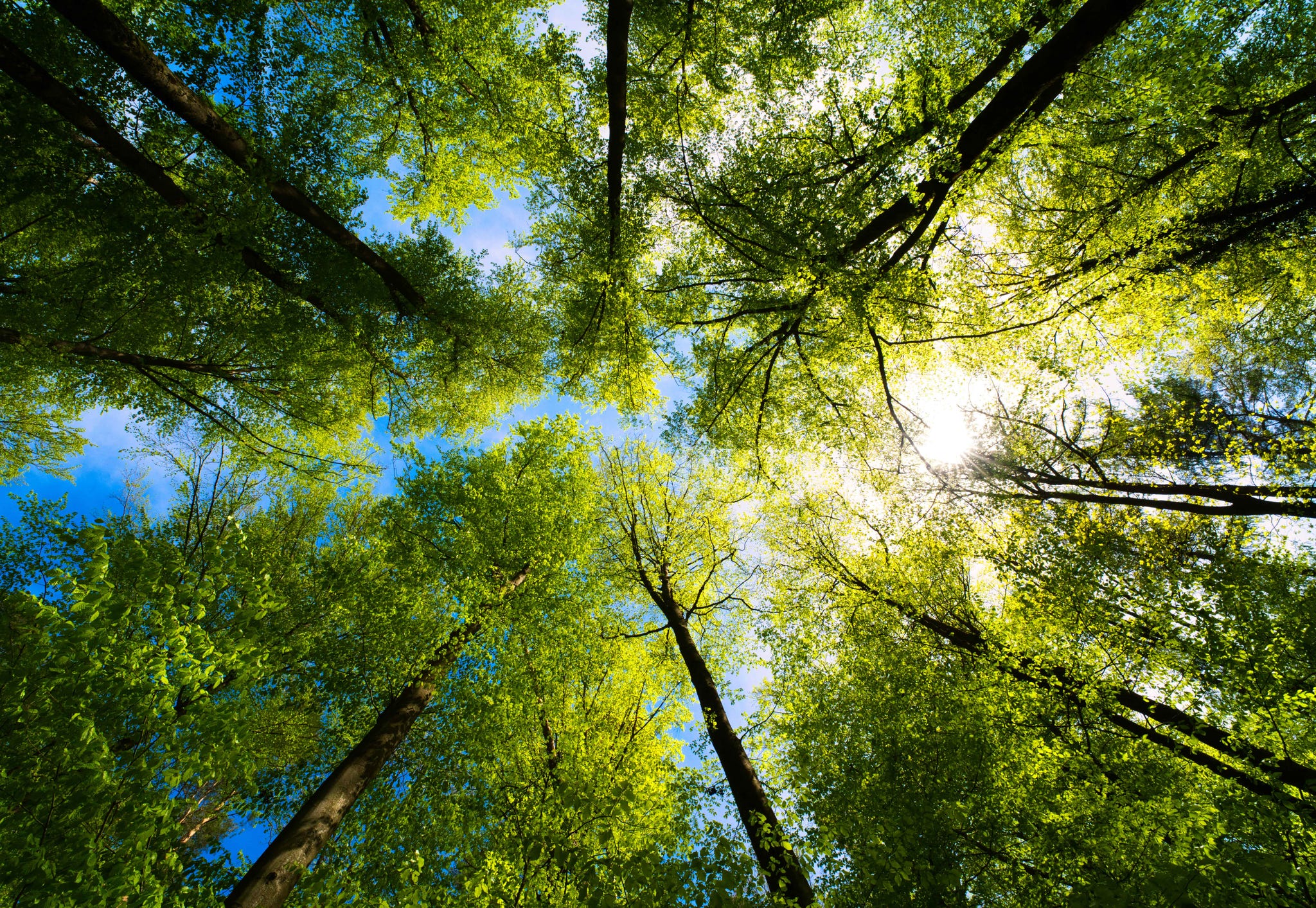What If Therapy Could Be a Walk in the Woods?
There’s a special shade of green—somewhere in between a yellowy chartreuse and a loud neon—that hits the trees in Philadelphia each spring and summer. I had never noticed it before, this green that enthusiastically and bossily announces that it is green, but then again, I had never noticed a lot of things before this year, when I first began wandering into the woods. As soon as the new leaves started to sprout in April, a break from the browns and grays of winter, I could feel myself channeling my former ecotherapist, Lauren Kahn, while staring out into the forested distance. When we used to walk into the woods together, she would ask: “What do you notice? What do you see?”
Like most local lore, my introduction to ecotherapy came by way of one of those cool friends who are always in the know while we shot the shit late one night. She had been looking for a therapist when she moved to the northwest part of Philly—the area that backs up against Wissahickon Valley Park, a 2,000-acre spread of rich woodlands and trails on Indigenous Lenape territory—and, via Google, happened upon the Psychology Today page for Kahn, whose professional photo was accompanied by several others of the leafy green woods. In her profile, Kahn wrote that she offered outdoor sessions, and that appealed to my friend, so she reached out and began doing therapy in the park with her. For me, after years of in-office therapy, then phone therapy, then my therapist eventually retiring in a waterfalling series of downgrades that came as a necessity of the pandemic, the thought of taking a walk outside with a licensed professional sounded ideal.
These sessions with Kahn—which my partner and I attended as couples therapy for a year—included short, slow-paced walks or seated sessions among the trees of the Wissahickon, with special attention paid to the natural surroundings. Sometimes, the three of us would wander to specific landmarks in the park—the stables to see the horses, the great beech tree, the rocky patch of land by the creek where people bring their dogs to play. While we walked, we would talk, sometimes loosely on a subject, other times picking up signs from the world around us, like the way the wind was blowing or if the sun was shining brightly. Much like traditional talk therapy, issues of family, partnership, and our relationship to ourselves, each other, and the world around us came up, but with the added benefit of movement, or sitting and literally touching grass. Often, Kahn would stop us for what she called “mini mindfulness moments”—if conversation was stalled or charged in any way, we could pause and take in some small detail of the park, admire a tree, or breathe in the smell of the leaves. Having spent most of my adult life in a constrained, tightly wound urban setting, it didn’t take long for me to learn how out of touch I was from nature.
“When you take people outside for therapy, it kind of naturally happens that people begin to see nature a little differently. We do this mindfulness work and sometimes we will find interesting things that are occurring in nature, whether it [is] the weather, the change of seasons, the animals, the birds, the life cycle,” Kahn explains in an interview, after my partner and I had decided to pause therapy for a while. “What we think of as life—living to dying—happens in front of us very concretely. You see it. You experience it.”
Kahn says her practice of bringing patients outside initially began as a small ask a little over 10 years ago. She had a background in wilderness therapy and outdoor courses with children, and so when she began developing her private practice, every so often, she would ask her clients, “Would you like to go outside for your session today? Would you like to take a walk?” Then, she began to dig into more research around nature therapy and learned that there was a growing subset of practitioners in the field of psychology who prioritized the great outdoors. Inspired by and honoring Indigenous wisdom, Kahn began to see the deep promise and possibility of incorporating nature into her practice. When a colleague needed an office for a full day, Kahn decided to designate Wednesdays as the day when she would head outside for sessions. “I would [tell clients], ‘I see people outside on Wednesdays. Is that something you’d like to do?’ Almost everyone would say yes.”
When the pandemic hit and her office closed, Kahn saw more clients outside than on Zoom. “Then, when our building opened up again, I went back to this tiny space because I had given my larger office to a colleague who was doing more indoor work, and it just didn’t feel right to me. There was a brick wall outside the window. I couldn’t see any trees. There was no good natural light,” she says. By then, Kahn had come to identify primarily as an ecotherapist.
She sent her clients waivers requesting that they not hold her responsible for acts of nature, said goodbye to the office, and never looked back.
While it can sound a bit woo-woo to work through emotional pain while clutching a tree, ecotherapy in its disparate forms has a long, entrenched history as a practice. “Indigenous peoples all over the world have been practicing earth-connected healing since the beginning of time, so it is very deep in our bones,” Ariana Candell, an ecotherapist based in California and founder of the Earthbody Institute, explains. “It’s deep in our body [and] deep in our spirit to have a connection with different parts of the natural world and to feel uplifted, to feel held, to feel safe.” Many of these traditions in the U.S. have long been buried, hidden, or remained underground, Candell says. The work that she and other ecotherapists are trying to do now is put people back in touch with how nature can be a source of healing.
In 2019, a paper published Scientific Reports found that people who spent a minimum of 120 minutes a week in or around nature reported good health and well-being. For J. Phoenix Smith, a Washington D.C.-based ecotherapist and founder of The Alliance for Ecotherapy and Social Justice, that hardly feels like enough. “You have to fight for your nature time,” she says over the phone. When Smith conducts ecotherapy sessions, even over Zoom, she tells clients that their homework is to log 120 minutes of nature time a week as part of their work together. Pointing to research that indicates Americans spend 90 percent of their time indoors, Smith says—as opposed to a $200 massage or the latest wellness trend—getting out into nature can be a low-barrier, low-cost stress-relieving practice.
The low barrier to entry, though, is still not low enough: therapy is expensive, frequently not covered by insurance, and due to the escalating mental health crisis in America, therapists of all backgrounds are in high demand. Access is one of the reasons that Laura Marques Brown, an ecotherapist based in Maryland, hosts her therapy sessions in partnership with Maryland Therapeutic Riding, a horse farm in Crownsville. “I don’t meet clients at a park or on a trail—because I can’t bill insurance if I do that. Insurance will literally deny claims if you are not associated [with] a location. And so that’s one reason why a lot of ecotherapists are out of pocket,” Marques Brown says. This workaround has helped Marques Brown develop her equine therapy practice, as well as build a relationship with the land that she brings her clients to. She’s familiar with the topography and what to expect when she brings people there, which makes doing the work that much more seamless.
There are also questions of accessibility for ecotherapy—taking a walk in the woods might be less accessible than a Zoom call for people with disabilities. “If we are indoctrinated to believe that nature means a park or a trail, then we don’t get to experience the patch of grass in between the parking lot. We start to lose the value of that little tree just right outside my window. Even the power of having a house plant,” Marques Brown says. Many ecotherapists were faced with the challenge of doing their work during the pandemic when they wanted to continue seeing clients who were immunocompromised or preferred to remain virtual. “How can I help my clients do ecotherapy just by facing a window and letting the sun hit their face or by opening their window if they can?”
These questions are part of the reason J. Phoenix Smith started the Alliance of Ecotherapy and Social Justice in 2020—as a means to have deeper conversations about ecotherapy, ones that go past only extracting from the land to satisfy our human emotional needs. “If we’re continually going to look at nature as something that we use for our own health and well-being and we are divorcing it from the social and political context and the need for climate justice and stewardship, then we are just continuing to repeat the same model that has led to the situation that we’re in today,” Smith says. Her organization focuses on fostering dialogue around accessibility, land stewardship, and political activism, so that this form of therapy doesn’t become prohibitively inaccessible.
Marques Brown starts every initial session with her clients by acknowledging the land. “A client will come to MTR, and before their first session, I’m always like, ‘Okay, so we are on Piscataway Conoy land. These are people who heavily relied on their relationship to water and we are going to take a minute here to recognize their presence. It’s still here.’”
Smith says that, while it’s not in the official job description of an ecotherapist to bring up the personal role people may play in Indigenous erasure, it can arise naturally. “I find that people become much more open and relaxed on the land than they do in a office,” Smith says. “Nature does the work for you in many ways. When I ask about their ancestral history and connection to the land, stories start to come out. Eventually, we get to Indigenous people because you’re gonna have to. How’d you come here? How’d they get this land?” Smith says she doesn’t need to belabor the point with people—chances are, if you’re interested in doing therapy on the land, you’re going to be open to talking about your relationship with the land.
“When people fall in love with the earth, then they start to care more,” she says.
I would be lying if I said I didn’t come to ecotherapy originally to process some of the anxious feelings I’ve had related to climate change. For therapists like Candell, this is not uncommon. “It’s still a little bit taboo in our country to say, ‘Oh my god, I’m terrified of what’s happening to our planet,’” Candell says. As we spoke, she began to tear up. Candell is one of the many therapists who have been trained and certified in “climate-aware therapy,” a practice that brings knowledge and background about climate change into their work—no climate deniers welcome.
“It’s a whole thing, because [certain clients] don’t want to bring children into this planet because they’re worried that it’s going to be so horrible in the next 10, 20, 30, 40, 50 years,” Candell says. “And that’s something that more and more climate-aware therapists are talking about. How do we support people with this? We take people’s concerns seriously.” From teachings learned from elders in the field, particularly Joanna Macy, Candell says that climate-aware therapists can help give voice to these concerns. “Climate grief is real and these feelings need to be talked about. They need to be felt, they need to be honored, validated, supported, because otherwise they’re under the surface. And when we sit on intense feelings, that’s never good for the body or the mind or the spirit.”
Kahn, my former therapist, finds addressing those fears is even more helpful in nature, when you’re able to actually witness in real time what is currently at stake. “We often start the session talking about the weather—because from week to week it can be so different,” Kahn says. “People often talk about their concerns, their worries, their fears. Where are we headed? [Climate anxiety] often does become part of what people bring to therapy, more than when I was doing this work inside.”
In one of the last sessions we had with Kahn, she took my partner and I to the Discovery Center, a nonprofit nature-based organization that sits on a reservoir in Philadelphia’s Fairmount Park. There, walking around the reservoir and talking about an issue we had been facing in our relationship, I was struck by the birds gathering on the surface of the water, floating along peacefully. They were together, and I felt a longing to better understand them, in the same way that I was trying to better understand myself and my relationship. Climate anxiety had been occupying a huge part of my psyche for the past few years—in watching the birds gather on the water, I started to see the natural world differently. Like my relationship, I had to see my place in nature as an ongoing project, its own partnership that required investment, patience, and care. Being in nature consistently, while also talking about my feelings, presented me with lessons that I hadn’t ever been available to hear.
Krista Nelson, a sixth generation Lenape grandmother who practices ecotherapy in Wissahickon Valley Park, says that much of her work deals with grief. Talking in nature helps people confront the constant cycles in life. “We know where we’re at, we know the damage that’s been done, but we aren’t certain about what comes next. And when we feel like there isn’t anything that we can do, we get that sense of hopelessness,” Nelson says. Walking through or sitting in the woods during different seasons teaches people to both love change and recognize its inevitability. “We talk about the illustration of death and dying and breaking down and new life coming out of death—life in the midst of death. There’s an opportunity for acceptance, and in the midst of that acceptance, a sense of hope and possibility.”
For Nelson, honoring Indigenous wisdom is an essential part of loving the land. “Learning to speak the language, thinking, oh my gosh. Lenape lived here. In Pennsylvania. In the Wissahickon,” Nelson says of her experience sharing the Lenape language with her ecotherapy groups. “I’m still learning, but I allow for it to speak through me, to come to me—especially in the woods.”

Freelance Writer
Dayna Evans is a writer in Philadelphia. You can read her work here.








